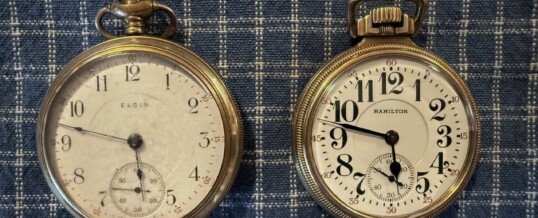
My friend runs a precious metals shop, selling mostly gold and silver. I was there to discuss those very things when a pocket watch caught my eye. An Elgin.
My buddy sells a few watches, mostly Rolex. That’s what made the Elgin stand out.
“Never seen a pocket watch in your store,” I told him.
“It’s just for looks,” he said. “I bought them to scrap for the gold.”
I was taken aback. My father collected pocket watches, and I inherited them when he passed. All have been cared for and maintained.
The very idea that a faithful timepiece would be gutted and trashed just for what little bit of precious metal it held was shocking and sad.
“How much would you take for both of them?” I asked.
“John, this is happening all over the country,” he replied. “With gold as high as it is, it’s now worth the effort to scrap old watches for what they have in them.”
My heart sank even more.
So, I repeated. “How much for both?”
He pulled the Elgin from the showcase and fished the other, a Hamilton, from the plastic Folger’s Coffee can where he’d tossed it.
The estimated amount of gold was figured in each watch and an amount was tapped out on his desktop calculator. I agreed to pay that amount.
I left with my two watches and headed home hoping my dad was looking down to see what I’d done. I had no idea the condition of either watch, but they’d never see the scrap pile.
Arriving home, I pulled out my watch kit. It is a kit that’s grown over the years as I’ve added new timepieces, and have worked on ones that were my father’s or mine.
Since I saw the Elgin first, it was the first one to have my attention. The serial number indicates the watch was made around 1895.
It needed a slight cleaning and was soon ticking and tracking time.
The Hamilton revealed something I’d missed in my friend’s shop: it was virtually unused.
There are no cracks in the face, the numbers are all bright, the crystal is clear with no scratches, and the hands have the same bright, blackish-blue hue that they had when they left the factory in Lancaster, Pennsylvania, in 1926.
A model 992; this was a lever-set railroad watch.
The mainspring on the Hamilton had been over wound. I released it and then slightly wound the watch. It worked just fine.
A short 12 hours later, both watches were spot on keeping time. Another 12 hours passed and neither was off either slow or fast.
This level of craftsmanship represents what America was able to achieve in the late 1800s, and continue through the mid-20th Century. Watches went from something for the rich, to something for the masses. And we have the railroad to thank for that.
Before time zones were standardized and most people owned reliable watches, train collisions were a problem. If more than one train was scheduled on the same track a disaster could occur because the engineers’ watches didn’t keep the same time.
After an 1891 train collision in Kipton, Ohio, that was caused by an engineer’s watch stopping for a few minutes, the railroads required watches that were very exact.
This led to the creation of the Railroad Watch Standard. Watches were required to be accurate to within 30 seconds per week, adjusted to at least 5 positions, resistant to temperature changes, have a minimum of 17 jewels (to reduce friction), have bold, readable Arabic numerals and a white dial, and were lever-set like my Hamilton so that the time couldn’t be accidentally changed.
American watchmaking boomed. Companies such as Elgin, Hamilton, Illinois, and Waltham, were some of the bigger ones.
More watches meant cheaper prices. Suddenly, you didn’t have to be rich to have a really good watch.
Pocket watches gave way to wristwatches, which have given way to no watches since we can easily check the time now on our smartphones.
What were once the best watches in the world and valuable assets to almost everyone are now being scrapped for a few bucks worth of gold.
If you have or inherit an old pocket watch or other vintage timepiece, please consider saving it. We can’t save them all, but we can save the ones in front of us.
It’s worth our time.
©2025 John Moore
John’s books, Puns for Groan People and Write of Passage: A Southerner’s View of Then and Now Vol. 1 and Vol. 2, are available on his website TheCountryWriter.com, where you can also send him a message.
JUN
2025
